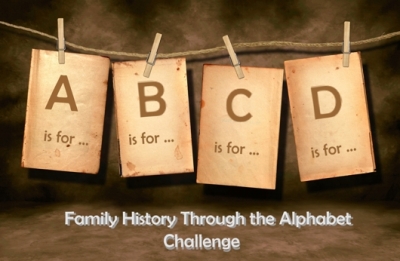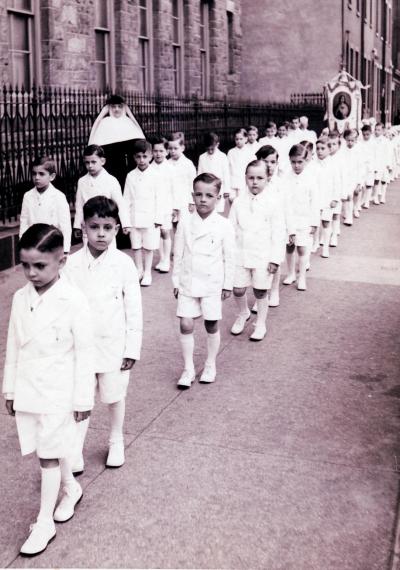Faith of our fathers, holy faith!
We will be true to thee till death.
~ Faith of Our Fathers1
The theme for the 99th Edition of the Carnival of Genealogy is Religious Rites. My ancestry is mostly Polish and a quarter Bavarian. Since Poland is about 99% Roman Catholic and Bavaria is the Catholic region of Germany, it is no surprise that my family is Catholic. I come from a long line of Catholic ancestors with the exception of one great-grandmother who was Protestant.
For my Catholic ancestors in Poland and Bavaria, religion played a major role in everyday social and cultural life of the towns and villages. All of the vital records I’ve found for these ancestors come directly from church records of baptisms, marriages, and burials. It is easy to see that my ancestors’ lives were intertwined with the church’s rites – many of my ancestors were baptized, married, and laid to rest in the same parish. It is impossible to know if my ancestors had a strong faith or if the church merely represented a cultural presence in their lives. Regardless of the answer, I am Catholic today by choice, but also in part due to the faith of all the fathers and mothers in my family history.

Top Row: My Grandmother and her two children - my father and aunt. Bottom Row: My brother, me, and my niece. All photos were taken on the day we received First Holy Communion.
Once my ancestors immigrated to the United States, they continued to practice their faith and their American-born children were baptized, made communion, confirmed, and married in the church. Whether or not my great-grandparents or grandparents had a strong faith, it was still passed down. Today, my parents, brother, and I all share a deep love for our Roman Catholic faith. For us, the celebrations of baptism, Holy Communion, confirmation, and marriage are not merely excuses for a worldly celebration, but they represent defining moments in our walks with God.
Faith is a rather serious topic, and since my genealogy adventures are usually on the lighter side, I’ve decided to approach the topic a little differently. In honor of the seven sacraments2 celebrated by Catholics, I present a list of unique, odd, or curious facts about my family’s participation in religious rites!
7 Sacramental Fun Facts About My Family
1. My maternal grandfather, Henry Pater, did not know he was baptized at all much less in the Catholic Church. When he and his wife had their civil marriage blessed in the church, the record indicates that he received a dispensation, presumably for not being Catholic. However, I found the record of his baptism at Our Lady of Grace Church in Langhorne, PA. My mother theorizes that since his mother was the Protestant in the family and they were living with his father’s Catholic parents and grandmother, the Catholic half of the family must have had him baptized without his mother’s knowledge!
2. We do not know where my paternal grandfather, James Piontkowski (later known as Pointkouski), was baptized. I plan on searching the churches near the address the family lived in 1910 when he was born, but Philadelphia is a very large city with many Catholic churches. The irony of not knowing where he was baptized in the city is that I found his brother’s baptismal record at Św. Stanisława in Warsaw, Poland – another very large, very Catholic city. I thought that would be impossible to locate the correct church, but it was an easy find. Surprisingly, I found out that Philadelphia has more churches than Warsaw! According to the 1912 Catholic Enclyclopedia3, Warsaw had 414,620 Catholics and only 40 churches and chapels. In comparison, the 1911 entry for Philadelphia4 indicated that there were 525,000 Catholics in the city in 1910 with 434 churches!
3. My mother and aunt have the unique designation of being the oldest baptismal candidates in my family tree. Their father was the agnostic son of the Catholic-Protestant marriage, and their mother was the lukewarm daughter of Catholics. For whatever the reason, my aunt, who was born in 1932, and my mother, who was born in 1935, were both baptized together at Nativity B.V.M. – around 1938-39, likely at the insistence of their maternal grandfather. My mother was old enough to remember walking into the church, and she remembers her horror when the baptismal waters wet her fancy new dress. My aunt just remembers being embarrassed that she was so old and getting baptized like a baby.
4. In Philadelphia, or upon meeting a fellow Philadelphian, it is common to ask, “What parish are you from?” rather than “What neighborhood are you from?” The Catholic identity was so strong, and the parish boundary rules were so strict, that parishes and neighborhoods were one and the same. I received the sacraments of Baptism, Reconciliation, Holy Communion, and Confirmation in the same parish (Our Lady of Calvary). While my parents and grandmothers also received the sacraments in the same parishes (St. Peter’s, Nativity B.V.M., and St. Adalbert’s), my brother and grandfathers did not. My maternal grandmother can add to her list one more sacrament received at the same parish – Marriage.
5. I never thought to ask my parents about their Confirmation names until writing this post. In the Catholic tradition in the U.S., the candidate often adopts the name of a saint that they admire. In my family, the confirmation names of my father, mother, brother, and me are John, Patricia, Richard, and Jamie.
6. If it was not for the baptismal record of a collateral relative, I never would have found the birthplace of my Bavarian great-grandparents. All other records including passenger lists and death records did not list the town from which the Bergmeister’s came. It was only in looking for their children’s baptismal records that the town was identified; their oldest son’s record listed the town name! This information may not always be included, but the fact that they attended a German-speaking Catholic church helped (St. Peter’s).
7. According to Canon Law, a person’s baptismal register should also include annotations for their confirmation and marriage or holy orders. I’m not sure when this rule was instituted – I’ve occasionally seen it in my ancestors’ records, but not always. But I have a rather curious honor – I entered my confirmation date into my own baptismal record! In 1981 my friend and I were helping out at school, and one of the tasks that Sister needed help with was the recording of confirmation data in the parish registers, including our class’s confirmation from 1979. Since I was baptized in the same parish (my friend was not), I got to annotate my own baptismal record. I don’t think too many folks can say they’ve done that one.
Down in adoration falling,
Lo! the sacred Host we hail,
Lo! o’er ancient forms departing
Newer rites of grace prevail;
Faith for all defects supplying,
Where the feeble senses fail.
~ Tantum Ergo5
References:
1Faith of Our Fathers is a hymn with words by Frederick W. Faber, 1849 and the refrain (cited above) by James G. Walton, 1874.
2Get out your catechism, class! If you forgot what all seven are (or if you are not Catholic), they are: Baptism, Reconciliation, Holy Communion, Confirmation, Marriage, Holy Orders, and Anointing of the Sick.
3Palmieri, A. (1912). Archdiocese of Warsaw. In The Catholic Encyclopedia. New York: Robert Appleton Company. Retrieved October 30, 2010 from New Advent: http://www.newadvent.org/cathen/15555a.htm
4Loughlin, J. (1911). Archdiocese of Philadelphia. In The Catholic Encyclopedia. New York: Robert Appleton Company. Retrieved October 30, 2010 from New Advent: http://www.newadvent.org/cathen/11793b.htm
5Tantum Ergo is a hymn by St. Thomas Aquinas written in 1264.
[Submitted for the 99th Carnival of Genealogy: Religious Rites]










